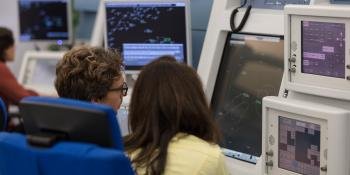ATM recently spoke with 42 Solutions about its fallback solution Merlin. How it’s being used in live applications now and how it might evolve in the future.
Today Merlin is live at LVNL. The product was initially developed as a prototype working with LVNL ATCOs to understand their specific requirements and ways of working. It was refined and deployed based on this collaboration. Merlin is a fully independent ATC system that can support primary, fallback or contingency solutions. It can be used as a primary ATC position or as a contingency for continuation of services after a failure of a primary system.
LVNL has two scenarios for use of the Merlin system. It is deployed in their contingency centre and as a last resort air situation display in their main centre. The contingency operations solution has been developed in accordance with the Software Assurance Level 4 objectives of ED-153 and complies with the EC interoperability requirements.
Key features of the system include:
- track, plot and weather processing
- role-based user interface with tailored touch input panel, label layouts and airspace maps
- executive input broadcasting for sound situational awareness across the air traffic controller positions
- touch input panel emulation for seamless transition from main to last resort.
As a fallback solution to the main system, no central server is required. Each stand-alone position shares data across the other ATCO positions.
It also will be implemented at the main area control centre at Schiphol Airport. There it will take the role of last resort alongside the Phoenix back-up system and Amsterdam Advanced ATC (AAA) system thereby realising a full independent 3-lane system.
The fallback system is always running in the background to ensure redundancy and provide the ability to conduct error checking. In times of slow periods, the system can be activated to ensure ATCOs have the opportunity to work with it live. Switch over always involved human intervention in order to make this change of functionality. there is no chance of the system automatically switching on or not switching on when it is desired to do so.
What might the future hold?
Looking ahead for additional uses of the Merlin solution, there were a few options we discussed. First being the support of smaller ANSPs as their primary ATC solution. Although there are organisations now releasing ATC-as-a-Service solutions also addressing this market, 42 Solutions feels their solution comes at a comparable cost. These enables smaller organisations who prefer to have equipment on site to do so.
Remote digital towers could also be a possible future solution, although this topic still requires some research and validation.
Lastly, is the possibility to provide disaster support. In the event of the loss of the ATC infrastructure, a deployable fallback solution based on Aireon’s real-time ADS-B satellite data allows for functionality where there is little or no radar infrastructure.
What’s always interesting for ATM is to hear about solutions that appear to have a singular role initially and could evolve into options in other categories that may have not been initially considered.





